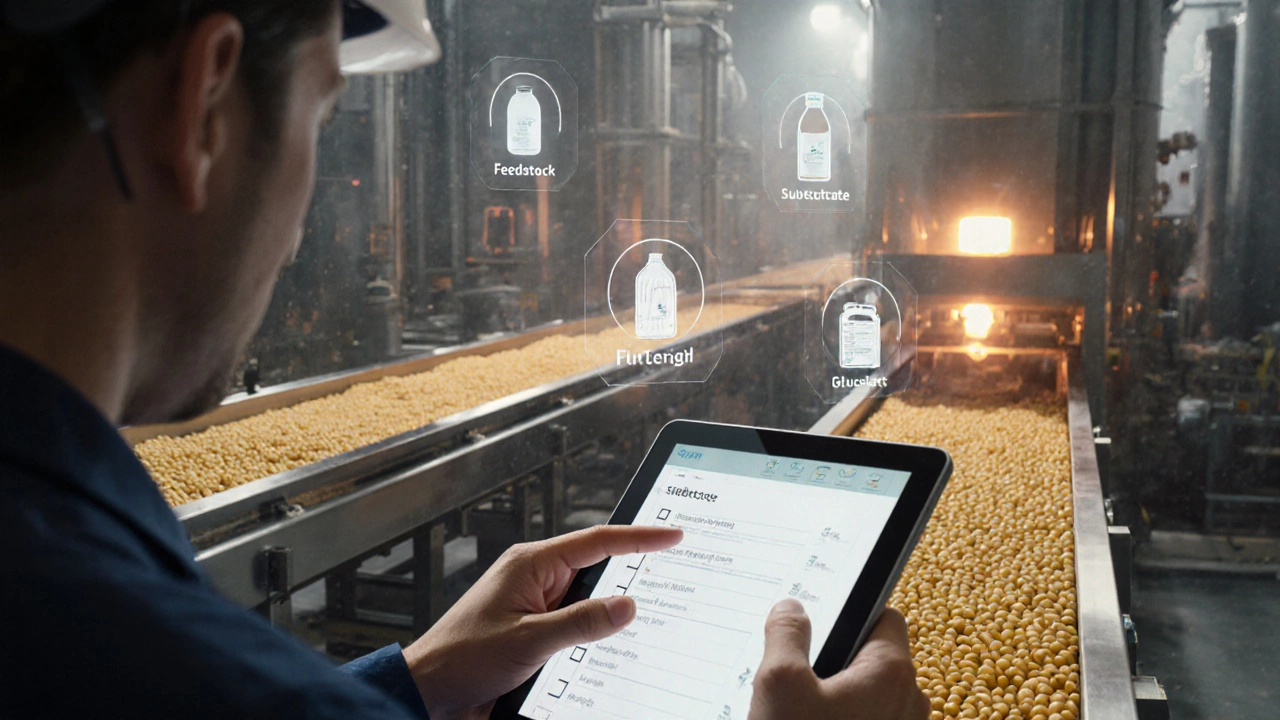Food Science Terminology Quiz
Test your understanding of scientific food terms. Choose the most appropriate term for each scenario based on the article content.
1. When a corn mill receives raw corn kernels for processing into corn syrup, which term best describes the corn?
Ever wondered why a microbiologist talks about a "substrate" while a nutritionist mentions a "ration"? The words scientists use for what we call food reveal a lot about their field, the process they study, and the scale they work at. Below you’ll get the straight‑talk on the most common scientific labels, when each fits, and why the distinction matters for food processing units.
Key Takeaways
- Scientists replace the everyday word “food” with precise terms like substrate, feedstock, and ration to match their discipline.
- Each term carries a specific scope - from raw biomass in a bioreactor to the balanced diet of an astronaut.
- Understanding the vocabulary helps engineers design safer, more efficient processing lines.
- A quick‑reference table lets you match the term to the field and typical example.
- Checklists and FAQs at the end make sure you’re using the right label for your project.
Why Scientists Don’t Just Say “Food”
In everyday life, “food” is a catch‑all. In a lab or a factory, that blanket term is too vague. Researchers need words that convey composition, purpose, and processing stage. For instance, a chemist studying enzyme activity cares about the substrate - the specific molecule the enzyme works on - rather than the whole meal. Meanwhile, a supply‑chain analyst tracks feedstock - the raw agricultural product entering a conversion facility.
This precision reduces miscommunication, aligns quality‑control standards, and speeds up regulatory approvals. When a food‑processing unit receives a shipment labeled “feedstock,” everyone knows it’s unprocessed raw material awaiting conversion, not a ready‑to‑eat product.
Core Scientific Labels and Their Typical Contexts
The list below covers the most frequently encountered terms, each introduced with a compact definition and a real‑world example.
-
Food is the general term for any edible material that provides nutrition or energy to organisms. In policy documents, you’ll still see “food” used when the audience isn’t specialized.
-
Nutrient refers to specific chemical components - carbs, proteins, vitamins - that support physiological functions. Nutrition scientists calculate the nutrient profile of a diet.
-
Substrate is the material a biochemical reaction acts upon. In fermentation, glucose is the substrate for yeast producing ethanol.
-
Feedstock denotes raw agricultural or animal material fed into a processing line, such as corn kernels entering a high‑fructose corn syrup plant.
-
Ration is a measured allotment of food for a specific group, commonly used in military, spaceflight, or disaster‑relief contexts.
-
Diet describes a planned set of foods for health or experimental purposes, e.g., a high‑protein diet for athletes.
-
Food matrix captures the physical structure that holds nutrients together, important in texture analysis and shelf‑life studies.
Comparison Table: When to Use Which Term
| Term | Primary Field | Typical Use | Concrete Example |
|---|---|---|---|
| Food | General / Policy | Broad discussion of edible items | Apples sold at a supermarket |
| Nutrient | Nutrition Science | Analyzing macro‑ and micronutrient content | Vitamin C in orange juice |
| Substrate | Biochemistry / Fermentation | Material consumed by enzymes or microbes | Glucose for yeast in beer brewing |
| Feedstock | Food Processing Engineering | Raw commodity entering a conversion plant | Corn kernels for corn syrup production |
| Ration | Logistics / Military | Standardized portion for a group | 3‑day MRE for soldiers |
| Diet | Health & Sports Science | Planned intake for a target outcome | Ketogenic diet for weight loss |
| Food matrix | Food Physics | Studying texture and nutrient release | Protein network in a cooked egg |
Practical Checklist: Picking the Right Word for Your Project
- Identify the audience - regulatory, engineering, or scientific?
- Determine the processing stage - raw input, in‑process, or finished product?
- Match the term:
- If you’re describing raw agricultural material, use feedstock.
- If you’re tracking a molecule for a biochemical reaction, say substrate.
- If you’re allocating portions for a group, choose ration.
- Cross‑check with industry standards (e.g., ISO 22000, FDA Guidance) to ensure compliance.
- Document the chosen term in SOPs to avoid future confusion.

Mini‑FAQ: Answers to the Most Common Follow‑Up Questions
Is “food” ever the correct term in a scientific paper?
Yes, when the paper’s scope is broad or when the authors discuss policy, market trends, or consumer behavior. In those cases, “food” acts as an umbrella term.
Can “substrate” refer to whole foods?
Technically no. In biochemistry, a substrate is a specific chemical that an enzyme acts on. Whole foods are complex mixtures, so scientists break them down into constituent substrates.
Why do food‑processing engineers prefer “feedstock”?
“Feedstock” signals that the material is unprocessed and destined for conversion. It aligns with supply‑chain language and helps differentiate raw inputs from intermediates and finished goods.
Are “ration” and “diet” interchangeable?
No. A ration is a fixed amount allocated for a group, often under constrained conditions. A diet is a personalized or experimental plan aimed at health or performance goals.
How does the “food matrix” affect nutrition labeling?
The matrix influences how nutrients are released during digestion. Regulators may require matrix‑adjusted values for ingredients like whole grains versus refined flour.
Next Steps for Food‑Processing Professionals
Now that you know the precise vocabulary, audit your documentation. Replace generic “food” mentions with the appropriate term, update SOPs, and brief your team. If you’re drafting a new process line, start by classifying each material as feedstock, substrate, or product. This linguistic hygiene not only clears up internal communication but also smooths regulatory reviews.
Need a quick reference? Download the handy cheat‑sheet in your inbox by emailing the R&D lead. And remember: the right word today can save you a costly re‑labeling exercise tomorrow.









